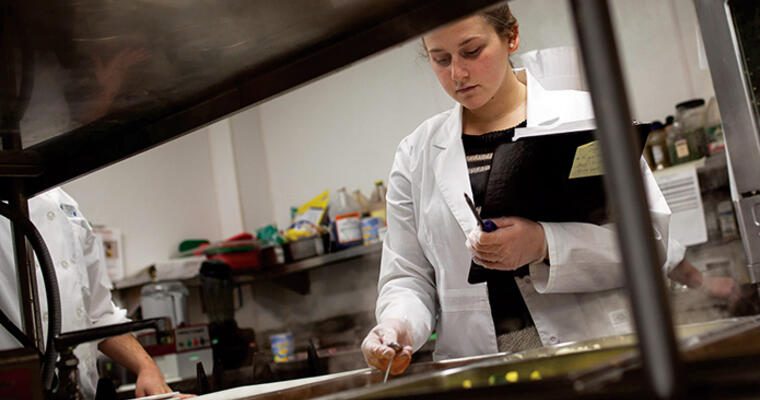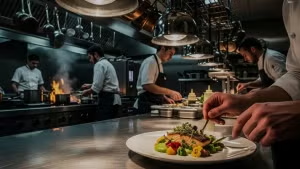Harmful contaminants cannot be seen, smelled, or tasted. That’s why it’s important to cook food to a safe internal cooking temperature to avoid illness. The minimum internal temperature at which pathogens are destroyed depends upon the type of food.
Use a Thermometer
Use a clean, sanitized thermometer to measure the temperature by placing the thermometer in the thickest part of the food. In sauces and stews, insert the thermometer at least two inches into the food. Be sure to calibrate thermometers regularly by inserting into a mixture of ice and water and adjusting the reading to 32°F/ 0°C. Thermometers that have been dropped or exposed to extreme temperatures should be recalibrated.
To ensure the food products being cooked are safe for consumption, use these temperature guidelines.
Cooking Temperature Requirements
Minimum internal temperature of 165℉ (74℃) for less than 1 second applies to:
- Poultry – including whole or ground chicken, turkey, or duck.
- Stuffing made with TCS (Temperature Control for Safety)ingredients.
- Stuffed meat, seafood, poultry, or pasta.
- Dishes that include previously cooked, TCS ingredients (raw ingredients should be cooked to their minimum internal temperatures).
Minimum internal temperature of 155℉ (68℃) for 17 seconds applies to:
- Ground meat—including beef, pork, and other meat.
- Injected meat—including brined ham and flavor-injected roasts.
- Mechanically tenderized meat.
- Ground seafood—including chopped or minced seafood.
- Eggs that will be hot-held for service.
Minimum internal temperature of 145℉ (63℃) for 15 seconds applies to:
- Seafood—including fish, shellfish, and crustaceans.
- Steaks/chops of pork, beef, veal, and lamb.
- Eggs that will be served immediately.
Minimum internal temperature of 145℉ (63℃) for 4 minutes applies to:
- Roasts of pork, beef, veal, and lamb.
- Minimum internal temperature of 135℉ (57℃) applies to:
- Commercially processed, ready-to-eat-food that will be hot-held for service (cheese sticks, deep-fried vegetables).
- Fruit, vegetables, grains (rice, pasta), and legumes (beans, refried beans) that will be hot-held for service.
Microwaving
When cooking with a microwave oven, the Food Code requires that all potentially hazardous foods containing meat, poultry, fish, or eggs shall be cooked to a minimum temperature of 165ºF. Other guidelines to follow when microwaving food include covering the food; rotating or stirring it halfway through the cooking process to compensate for uneven heat distribution; checking the temperature in at least two places to make sure the food is cooked thoroughly; and allowing food to stand covered for two minutes after cooking to obtain temperature equilibrium.
While cooking food to the appropriate temperature reduces pathogens, it does not destroy the spores or toxins those pathogens may have produced. This is why safe food handling prior to cooking is also very important.











